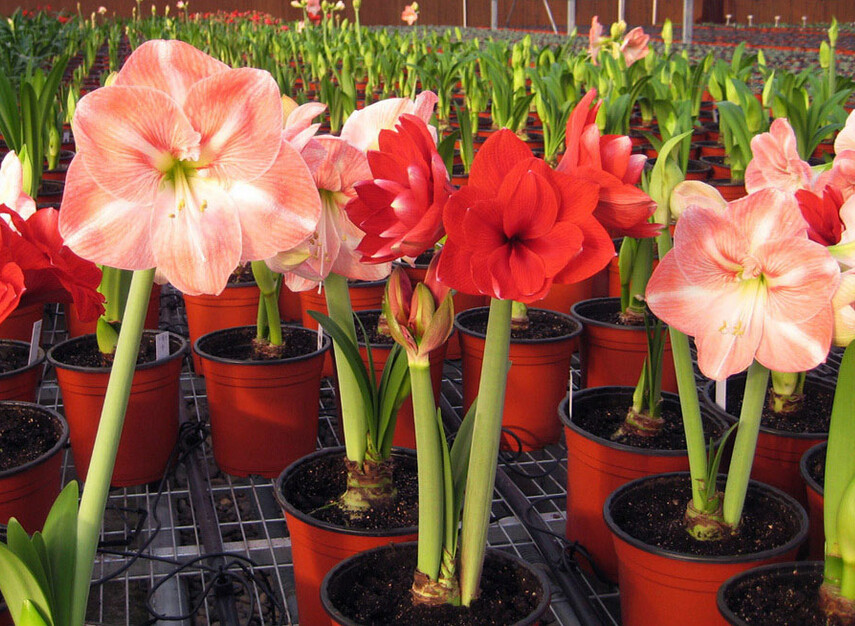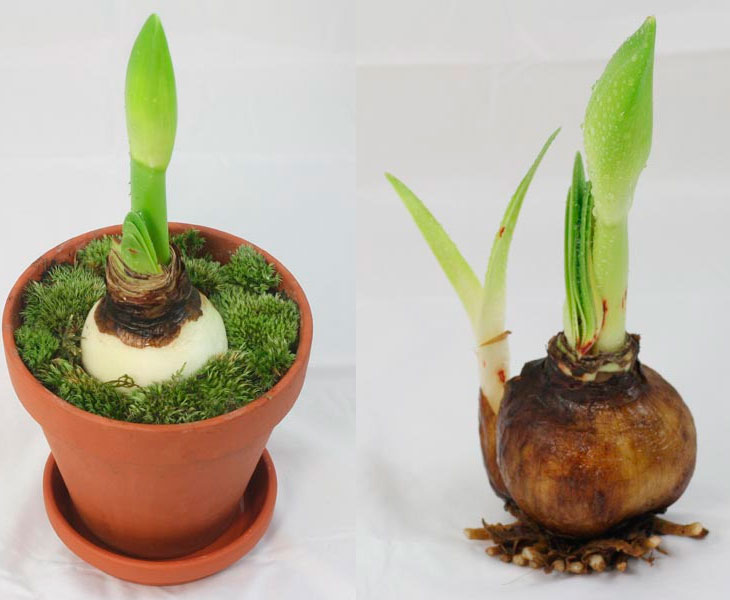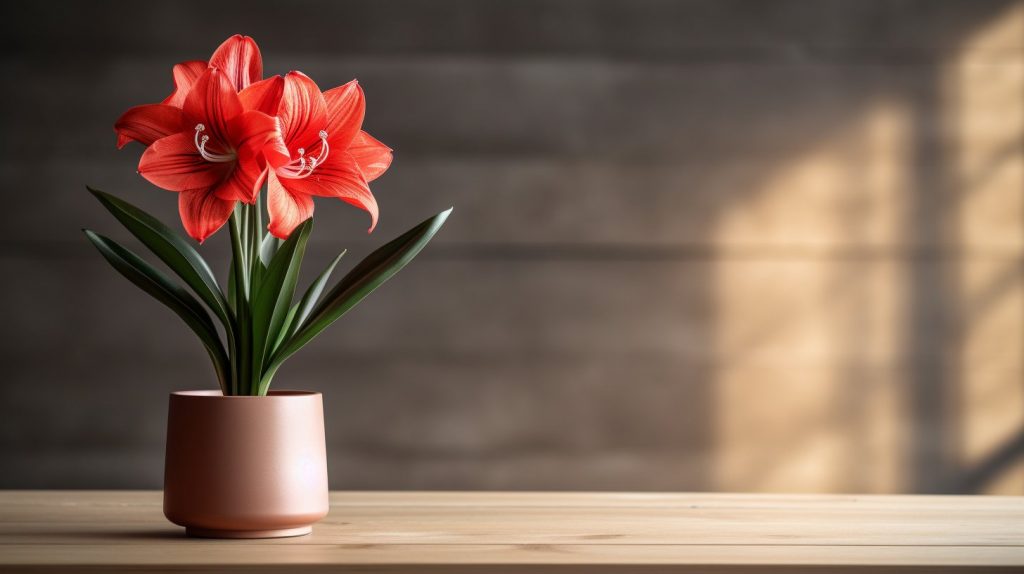Amaryllis, with its stunning, trumpet-shaped flowers and tall, graceful stalks, is a favorite among flower enthusiasts and a staple in many homes. This guide will take you through the journey of growing and caring for amaryllis, ensuring your bulbs blossom into magnificent flowers that can brighten any indoor space.
Amaryllis Overview: A Flower of Exotic Beauty
Amaryllis, also known as Hippeastrum, hails from tropical regions of South America but has captivated gardeners worldwide. Its ability to bloom indoors, especially during winter months, makes it a popular choice for adding color to homes during the colder season.
The amaryllis journey began in Africa and was brought to Europe in the 1700s. Known for their longevity, these plants can bloom for up to 75 years, making them a long-standing companion in your garden or home. The genus Hippeastrum is distinct from the true Amaryllis, known as belladonna, native to South Africa.
Amaryllis flowers range from 4 to 10 inches and come in various colors, including classic red, pure white, soft pink, salmon, apricot, rose, and deep burgundy. These hybrids produce flowers that can bloom indoors, brightening any room with their vibrant colors.

Selecting, Planting, and Caring for Bulbs
Selecting the right amaryllis bulbs and providing them with the proper care from planting through to blooming is crucial for a spectacular display of flowers. Let’s explore how to choose the best bulbs, plant them correctly, and care for them to ensure a bounty of beautiful blooms.
Selecting the Best Amaryllis Bulbs
When embarking on your amaryllis journey, the first step is choosing high-quality bulbs. Here are some detailed tips for selecting the best amaryllis bulbs:
- Size Matters: Generally, the larger the bulb, the more flowers it will produce. Look for bulbs that are substantial in size relative to their variety. Large bulbs can produce multiple flower stalks, offering a more impressive display.
- Firm and Healthy: The bulb should be firm to the touch, indicating good health. Avoid bulbs that feel soft or show signs of rot, as these are less likely to thrive.
- Inspect for Damage: Check for any signs of mold, decay, or mechanical injury. A healthy bulb should have a dry, papery outer skin and no visible damage.
- Look for Signs of Life: A bit of green growth at the top of the bulb is a good sign. It shows the bulb is alive and ready to grow. However, too much growth, especially if it’s pale and leggy, might indicate that the bulb has been stored in poor conditions.
- Offshoots: Some bulbs may have smaller offshoots attached. These can be planted separately but will take longer to flower than the main bulb.
Planting Your Amaryllis Bulb
Proper planting is essential for a healthy amaryllis plant. Here’s how to plant your bulb for the best results:
- Selecting the Right Pot: Choose a pot that is only slightly larger than the bulb. There should be about an inch of space around the bulb. Ensure the pot has drainage holes to prevent waterlogging.
- Potting Soil: Use a high-quality, well-draining potting mix. A blend that includes organic material and perlite or vermiculite works well for amaryllis.
- Planting Depth: Plant the bulb so that the top third to half of it is above the soil. This allows the neck and shoulders of the bulb to be exposed to air, preventing rot.
- Initial Watering: After planting, water the bulb thoroughly, allowing excess water to drain. Then, wait to water again until you see new growth. This helps prevent rot while the roots are developing.

Caring for Amaryllis Bulbs
Once your amaryllis is planted, proper care will ensure the plant grows vigorously and produces stunning blooms:
- Light: Place your potted amaryllis in a bright, sunny spot. A south-facing window is ideal. If natural light is limited, especially in the winter months, supplement with artificial light.
- Watering: Water the plant when the top 2 inches of soil feel dry. Be careful not to overwater, as this can lead to bulb rot. Consistent, moderate watering is key.
- Fertilizing: Once the plant has sprouted, begin fertilizing with a balanced, water-soluble fertilizer. Continue to fertilize every 2-4 weeks until the bloom period is over.
- Supporting the Stalks: As the flower stalks grow, they may need support to prevent them from toppling over. Use a stake or a slender stick to support them gently.
- Temperature: This plant prefers a warm environment but not too hot. Aim for daytime temperatures around 70-75°F (21-24°C) and slightly cooler at night.
- Avoiding Drafts: Keep your amaryllis away from drafts, heating vents, and air conditioners. Sudden temperature changes can stress the plant.
By carefully selecting healthy bulbs, planting them in the right conditions, and providing attentive care, you can successfully grow amaryllis bulbs indoors. These magnificent flowers not only add a splash of color to your home but also bring a sense of accomplishment as you watch them grow and bloom under your care. 🌱🌺💧
After-Flowering Care: Keeping Your Amaryllis Happy
Once your amaryllis has bloomed and graced your home with its spectacular flowers, it enters a crucial phase of care to prepare it for future blooming seasons. Proper after-flowering care ensures that your amaryllis remains healthy and continues to produce stunning blooms year after year.
Caring for the Amaryllis Post-Bloom
After the amaryllis flowers have faded, it’s important to give the plant the attention it needs to replenish its energy reserves for the next blooming cycle. Here’s how you can care for your amaryllis after it blooms:
- Cutting Back the Flower Stalk: Once the flowers have faded, cut the flower stalk about 1 to 2 inches above the top of the bulb. Be careful not to damage the foliage, as the leaves are essential for photosynthesis, which helps replenish the bulb’s energy.
- Maintaining the Foliage: Keep the leaves intact and healthy. Continue to water and fertilize the plant regularly to encourage strong, green leaf growth. The leaves will continue to gather sunlight and produce energy for the bulb.
- Sunlight Exposure: Move your potted amaryllis to a bright, sunny spot if it’s not there already. Amaryllis leaves thrive in bright light, which is essential for building up the energy reserves in the bulb.
Transitioning Amaryllis Outdoors
After the last frost in spring, your amaryllis can benefit from being moved outdoors:
- Acclimation: Gradually acclimate the amaryllis to outdoor conditions. Start by placing it outside in a shaded area for a few hours each day, gradually increasing its exposure to direct sunlight.
- Outdoor Placement: Once acclimated, place your amaryllis in a sunny location where it can get at least 6 hours of direct sunlight daily.
- Continued Care: Continue to water and fertilize your amaryllis while it’s outdoors. This ongoing care is crucial for the bulb to build up the necessary nutrients and energy reserves for the next blooming season.
Inducing Dormancy for Controlled Blooming
Amaryllis bulbs do not necessarily require a dormant period to bloom, but inducing dormancy can help control when they flower:
- Initiating Dormancy: To induce dormancy, reduce watering in late summer or early fall and allow the leaves to die back naturally.
- Storing the Bulb: Once the foliage has died back, store the bulb in a cool, dark place for a period of 8 to 12 weeks. This could be in a basement or a cool closet. Avoid watering during this time.
- Checking the Bulb: Inspect the bulb periodically during dormancy. Look for signs of mold or decay and ensure it remains dry.
- Restarting Growth: To restart growth, bring the bulb back into a warm, sunny location. Begin watering and fertilizing to encourage new growth, and within weeks, you should see the signs of a new bloom cycle starting.
Repotting Amaryllis Bulbs
Repotting is an essential part of indoor amaryllis care:
- When to Repot: It’s best to repot your amaryllis every 3 to 4 years, ideally after it has gone through a dormant period. This helps to refresh the soil and provide the bulb with more space to grow.
- Repotting Process: Carefully remove the bulb from the pot and gently shake off the old soil. Inspect the roots and bulb for any signs of disease or damage. Choose a new pot that is slightly larger than the bulb and has good drainage. Repot using fresh, well-draining potting mix.
Monitoring for Pests and Diseases
Even with the best care, amaryllis can sometimes encounter pests or diseases:
- Common Issues: Watch out for pests like narcissus bulb fly and diseases like red blotch. These can be more prevalent when the plant is stressed or in poor growing conditions.
- Preventive Measures: Ensure good air circulation around your plant and avoid overwatering. If you notice any signs of pests or diseases, treat the plant immediately with appropriate measures.
Ensuring the Best Care for Your Amaryllis
Optimal Growing Conditions
To grow amaryllis successfully, provide it with bright, indirect light and moderate watering. Ensure the top 2 inches of soil are dry before watering again. Hippeastrum enjoys a warm environment but can tolerate a range of indoor temperatures.
Fertilization and Soil Health
Use a balanced, indoor plant fertilizer to keep your amaryllis nourished. The right potting soil, ideally a mix designed for flowering bulbs, will provide the necessary nutrients and drainage for optimal growth.
Understanding the Life Cycle
Hippeastrum has a unique life cycle that, when understood, can greatly enhance your ability to care for it effectively. From the initial planting of the bulb to the emergence of smooth leaves and the blooming process, each stage requires specific care to ensure the plant thrives and produces spectacular blooms.
Enjoying the Splendor of Amaryllis Year After Year
With the right care and attention, amaryllis can be a stunning addition to your indoor garden. Whether you’re a seasoned gardener or a beginner, these exotic flowers offer a rewarding experience with their dramatic blooms and easy-to-grow nature. By understanding and catering to the specific needs of your amaryllis, you can enjoy its magnificent flowers for many years, making it a cherished part of your home’s flora. 🌸🌱💧

Amaryllis FAQ: Expert Tips for Thriving Plants 🌺
1. How to Care for Amaryllis Indoors?
To care for Hippeastrum indoors, ensure it receives bright, indirect light. Water the plant when the top 2 inches of soil feel dry, and fertilize every two to four weeks during the growing season. After blooming, continue to water and fertilize to encourage leaf growth. Keeping the plant healthy and growing is essential for future blooming.
2. When to Cut Back Amaryllis Leaves?
Cut back amaryllis leaves when they begin to yellow or after a rest period if you are inducing dormancy. Generally, this occurs in late summer or early fall. Cutting the leaves allows the plant to conserve energy in the bulb, preparing it for the next blooming cycle.
3. Are Amaryllis Poisonous to Cats and Dogs?
Yes, amaryllis is poisonous to both cats and dogs. The plant contains toxic substances that can cause vomiting, diarrhea, and other adverse reactions if ingested. Keep plant out of reach of pets for their safety.
4. How to Plant Amaryllis Bulbs?
Plant Hippeastrum in a pot slightly larger than the bulb, using well-draining soil. Position the bulb so the top third is above the soil line. Water the potted bulb initially, then sparingly until new growth appears. Place in a bright location for optimal growth.
5. What to Do with Amaryllis After It Blooms?
After amaryllis blooms, cut the flower stalk close to the top of the bulb to prevent seed formation. Continue to water and fertilize as the leaves continue to grow. You can move the plant outdoors in summer for extra light.
6. How to Grow Amaryllis?
To grow amaryllis, start with a healthy bulb, plant it in suitable potting soil with good drainage, and provide it with plenty of light. Water regularly but avoid overwatering. Fertilize during the growth period and ensure the plant has a rest period after blooming to encourage future blooms.
7. How Do I Get My Amaryllis to Bloom Again?
To get your plant to bloom again, ensure it has a rest period. Reduce watering in late summer or early fall, allow the leaves to die back, and store the bulb in a cool, dark place for 8 to 12 weeks. Then, repot the bulb, water it, and place it in a sunny location to encourage new growth and blooms.
8. How to Store Amaryllis Bulbs?
Store amaryllis bulbs in a cool, dry place during their dormant period. You can leave the bulb in its pot or store it as a bare bulb. Ensure the bulb remains dry and is not exposed to freezing temperatures.
9. When Do Amaryllis Bloom?
Amaryllis typically blooms in late winter or early spring, depending on when the bulb was planted. Blooms can last several weeks. With proper care, you can time the blooming for the winter holiday season.
10. When to Plant Amaryllis Bulbs for Christmas Bloom?
Plant amaryllis bulbs in late September or early October for Christmas bloom. It usually takes about 6 to 8 weeks from planting to blooming.
11. Do Amaryllis Bulbs Multiply?
Yes, Hippeastrum can multiply. The mother bulb may produce smaller offshoot bulbs, which can be separated and planted to grow new plants. However, it takes a few years for these new bulbs to produce flowers.
12. Do Amaryllis Rebloom?
Amaryllis can rebloom annually with proper care. After the bloom period, continue to care for the foliage. Then, allow the plant to go dormant for a few months before starting the growing cycle again.
13. How Often to Water Amaryllis?
Water Hippeastrum when the top 2 inches of soil feel dry. During active growth, this may mean watering once a week, but be sure to adjust based on humidity, temperature, and light conditions.
Introduction
Nicki Mann, based in Portland, Oregon, is a good writer and houseplant enthusiast. With her background in environmental science, Nicki specializes in indoor gardening, focusing on sustainable and organic practices.
Experience
Her interest in houseplants began in her mid-twenties, leading to a career writing articles about indoor plant care and eco-friendly gardening for various websites.
Education
Nicki holds a Bachelor of Science in Environmental Studies from the University of Oregon, which underpins her approach to indoor gardening. She continually enhances her knowledge through horticulture and environmental sustainability workshops.
Personal Life
Nicki, an avid nature lover, enjoys exploring the Pacific Northwest's trails. She's active in community gardening and lives with her two rescue cats, who share her interest in her growing collection of houseplants.


